From
my recent diary
2018
Tuesday, December 18
I conducted 13 times of comet hunting sessions in November. It is
evident that the number is the record high through my observational
history. However, the number of clear sky is much less this month, and I
comet hunted three times including this predawn. First of all, I report
comet hunting session on Saturday, Dec.15 local time and the power of
Night Vison Device, and then, I will show you photos that I took this
predawn using my smartphone and NV.
Saturday, December 15
The sky condition on the day was the best since I have moved to Kumamoto.
At the same time the day fell on the maximum of Geminids, and I saw many
meteors. Air temperature was -4 degrees Celsius, but I felt it warm than
in Niigata.
I observed 46P Wirtanen by naked eyes. It had the diameter of 1 degree and
fourth magnitude. The comet looked blue greenish and apparent diameter of
0.8 degrees through 46 cm x 97 with Ethos 21 mm. With Night Vison (NV),
with a magnification of 37, it was strongly shining, but unfortunately, I
could not recognize the tint because NV is monochrome.
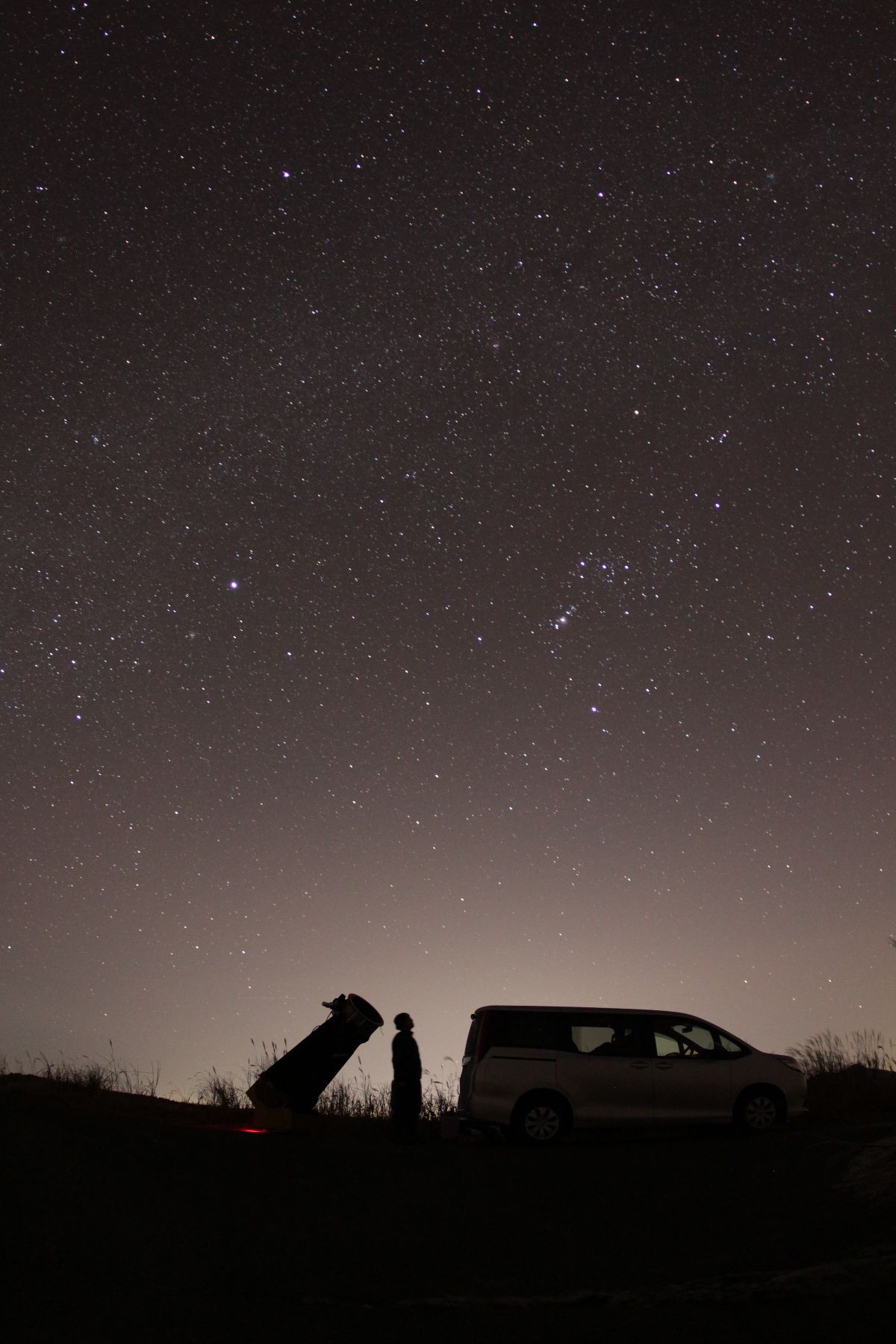
Photo was taken at the observing site in Aso City with an altitude of 940
m. 15mm F2.8, opened, ISO1600, 30sec.
Numerous stars were twinkling when I aimed NV with the magnification of
unity at the sky. In particular, the winter Milky Way that consists of a
great many fine stars was impressive and I felt as if had never been tired
of watching it. Barnarfs Loop, Rosetta Nebula and other HII regions looked
like that of photos through NV with a H¿ filter.
I tried to observe C/2016 N6 PanSTARRS having the magnitude of 13th to see
how dark comet look using usual glass eyepiece and NV. I managed to spot
the comet with magnification of 97 using Ethos 21 mm by comparing the
positon with the digital map. It was difficult work because the apparent
diameter was small, i.e. 0.3f. Using Ethos 13 mm, the magnification of
157, the image was large enough not to overlook during the hunting
session. Through NV with a combination of Lavendura 63 mm eyepiece and
Paracorr, the magnification of 37, the comet was much easier to observe
than with Ethos 21 mm, though small diameter of the object made it
difficult to recognize.
After testing NV, I began to search the sky at 4:35am local time. I
thought many hunters were sweeping near the ecliptic, and trained my
telescope at Arcturus, alpha Bootis. I comet hunted north of the star. Not
to mention, I applied NV for searching.
I could not identify any galaxy for more than half an hour. Though I knew
there are only dark galaxies around the region, I was depressed. At 5:09am
local time, I observed the first object, a pair of galaxies: NGC5859
(magnitude of 12.5) and 5857 (13.0). After that, I identified a pair of
NGC5928 and UGC9841, NGC5962, UGC9618, NGC6004 with 6003 and UGC9958.
Those were all comet like objects, all being galaxies, which I observed.
SkySafari 6 Pro showed UGC9618 has the magnitude of 15.3, but it looked
brighter and some literatures claim it is 14th.
I have ever identified a 15th magnitude galaxy only once using a glass
eyepiece. I have yet observed a 16th magnitude one using NV. I think NV
does not improve the limiting magnitude of such object drastically, but in
my experience I can observe a galaxy one magnitude darker with NV than
with a glass eyepiece. On top of that NV works well under the hazy or
light polluted sky and no need to use averted vision. In this respect, NV
is superior to the glass eyepiece.
Tuesday, December 18
I headed for the observing site near my house, since the sky was clear at
3:30am local time. When I finished setting up my comet-seeker, clouds
started to cover the sky. I had a plan to take photos of Rosetta Nebula,
but the position of the nebula had already hidden by clouds.
Alternatively, I changed the target to M104.
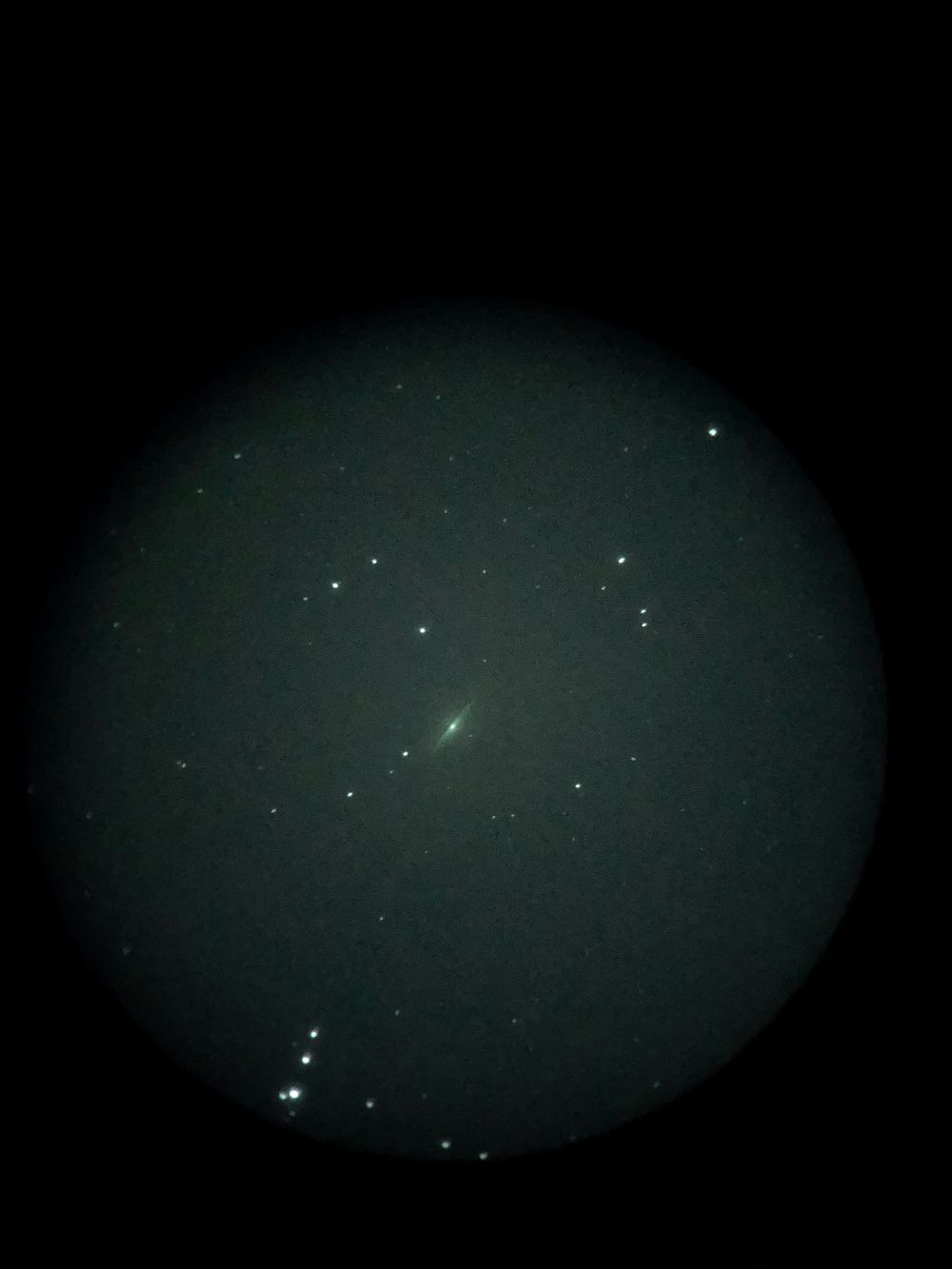
M104
Night Vision PVS-14, 46cm F4.5, 37x, iPhone X, 1/4 sec. f/1.8
2018/12/17.82581 UT
I wanted to try some ways of taking photos, but I was upset due to
appearance of clouds and I made a mistake to use the app gNaightCap
Camerah. All photos I took were the exposure time of 1/4 sec. and I cloud
not use auto composite function of the app. I had no choice and composited
the photos using PC software gStellaImage7h, but there occurred image
shift near the edge.
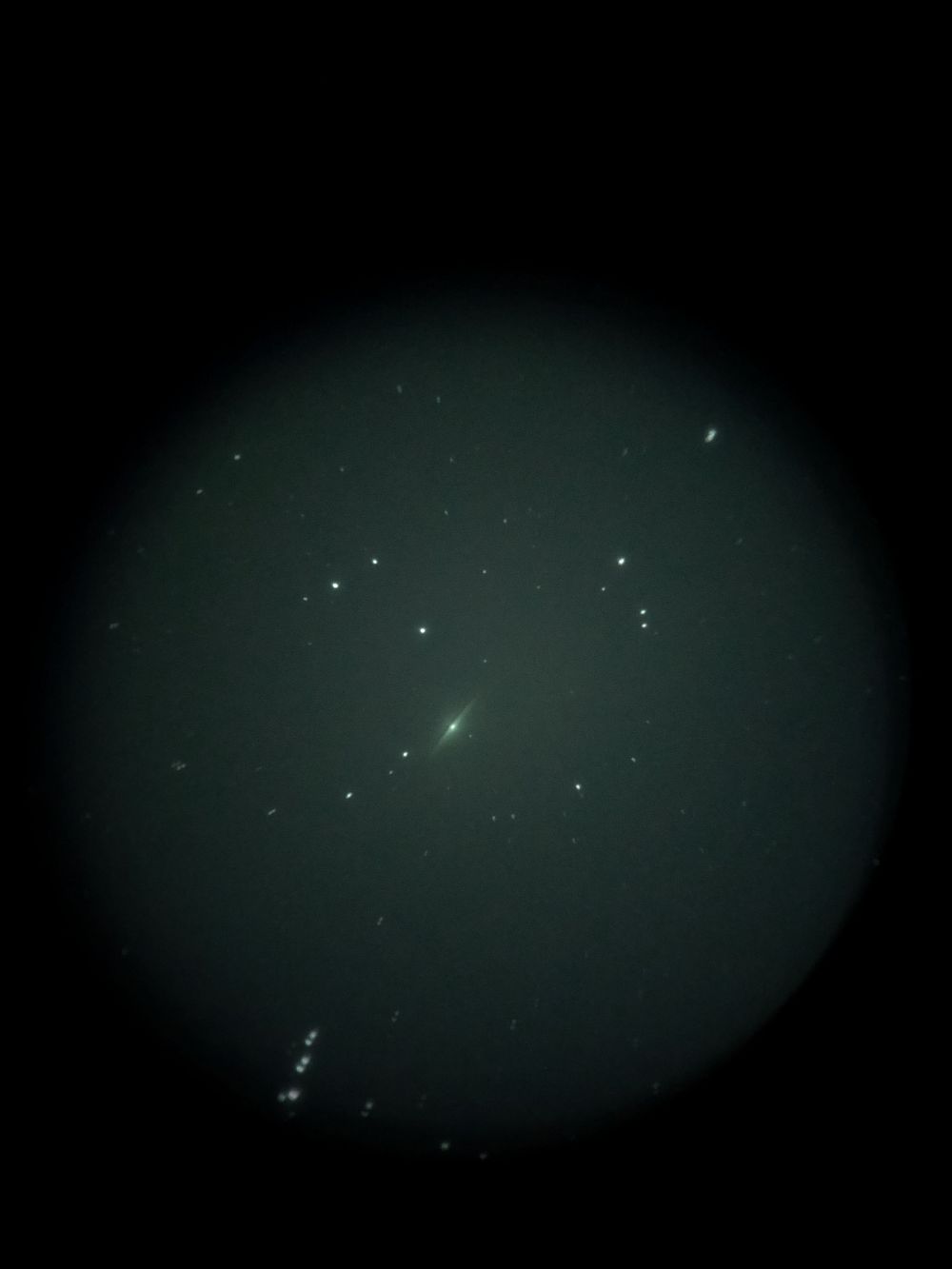
M104
Night Vision PVS-14, 46cm F4.5, 37x, iPhone X, 1/4 sec.x4 composit, f/1.8
2018/12/17.82581 - 17.82595 UT
Anyway, it is amazing that I could get such a nice photo only a
1/4-sececond of exposure.
After taking photos I comet searched through the gaps of clouds, however,
no comet like object was identified. But I saw many stars through thin
clouds. M13 was resolved into stars using 46 cm x 37 with NV, though any
stars were seen in the FOV of 5 cm finder due to cloud! I still do not
know exactly how NV is advantageous for comet hunting.
Tuesday, November 11
C/2018 V1 Machholz-Fujikawa-Iwamoto
Don Machholz, Shigehisa Fujikawa and Masayuki Iwamoto discovered a new
comet on 7th November UTC. Eight years have passed since the last visual
discovery, 332P (P/2010 V1) Ikeya-Murakami, and finally, Don discovered
the comet visually. On top of that, the comet has in three amateursf name.
I am very pleased with those things.
It has been nasty days during summer but in November we have many sunny
days. It was clear sky three consecutive days Monday, 5th November to
Wednesday, 7th November (JST), and I comet hunted for those days at
predawn. However, the comet was outside of my search area. On Monday, I
swept far south of the comet positon. On Tuesday, I started with the
session from some 7 degrees north of the comet. On Wednesday, I approached
within 10 degrees south of C/2018 V1 but I finished the session at the
point 30 minutes after the start of the twilight.
I observed the comet on Saturday, 10th November and the following day. On
Saturday it was 10th magnitude but on the next day it increased brightness
to the magnitude of 8.5. I could not observed a tail. It is expected the
comet becomes bright and reaches to naked eye object. I am looking forward
to observing the bright comet.
Revolutionary device: Night Vision
I started utilizing the Night Vision (NV) Device since the latter half of
October. NV is an electronic device that includes an image intensifier
with the magnification of unity. You can see stars with the limiting
magnitude of 8th to 9th using NV even under the full moon and/or at the
heavily light polluted area. If you look into the eyepiece of your
telescope through NV, the telescope works as if the aperture became twice
or three times as large as the original size depending the object.
However, for a diffused object like a comet, the degree of intensification
is less than that for a star.

From right to left: Night Vision PVS-14 (ACT PVS-14 Photonis 4G INTENS
Autogate P45 WP), Lavendura 63 mm eyepiece (made in Japan) and Paracorr.
Unfortunately, NV is very expensive as it is a military supply. https://www.nv-walker.com/product-page/act-pvs-14-photonis-4g-intens-autogated-p45-wp
In the US NV began to utilize many years ago. In Japan it has been
unavailable because it is a military supply, however, in those two years
the situation has changed and we can buy it from Europe. I think few
people us it for astronomy. Probably, the below is the sole report in
Japanese.
https://blogs.yahoo.co.jp/jzd01063/folder/1145795.html
I must say I have not yet made the best use of NV. I will report on the
device in the near future again. You can find many article on NV if only
you web search with the key word gNight Vision Cloudy Nightsh.
Reference: Article in the Sky & Telescope magazine
http://televue.com/Pdf/SkyTelescope_NightVision_June2018.pdf
Below I wrote
how it worked during the comet-hunting session on Sunday.
Sunday, 11 November
Wonderful clear sky! I saw the counterglow high in the western sky and
Canopus, alpha Carinae, crossed the meridian. The air was extremely dry
with the air temperature of 2 degrees Celsius and weak wind.
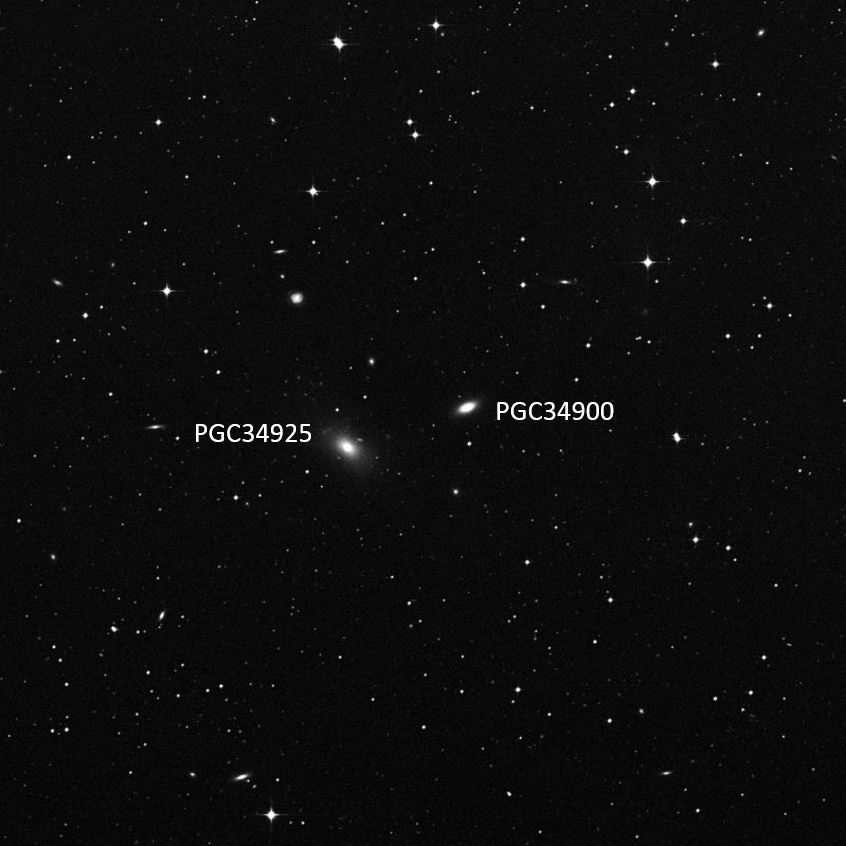
The faintest galaxy I identified, PGC34900, with the magnitude of 14.2 and
PGC34925 (mag. 13.9). The image is 30f wide.
The Digitized Sky Survey copyright © 1994
After observing 64P Swift-Gehrels and 38P Stephan-Oterma using NV with a
magnification of 37x, I began the hunting session with some 10 degrees
south of Regulus, alpha, Leonis. The first object that I identified was a
pair of galaxies NGC2962 and 2966 in the constellation of Hydra followed
by NGC2894 in Leo and NGC3044 in Sextans. The Antennae Galaxies, NGC4038
and 4039 were in the FOV at an altitude of only 4 degrees above the
horizon. The darkest galaxy I observed was PGC34900 with the magnitude of
14.2, and PGC34925 (mag. 13.9) was in the same FOV. Those pair was
identified at the altitude of 26 degrees. A pair of galaxies in the
constellation of Crater, NGC3791 (mag. 13.4) and 3771 (12.6), was observed
at the altitude of 23 degrees. The pair was not seen with a glass
eyepiece, Ethos 21 mm, 97x, which I used until in the first half of
October, but it was clear using NV.
The total number of galaxies that I observed was 23, but I have never
identified so many ones in the region. The result is due to the power of
NV. I believe this device make it possible to discover darker comets than
ever.
Saturday, October 13
I started the
comet hunting session at 3:48am (local time) from NGC2903, the galaxy in
the constellation of Leo. I did not set up dew remover for the secondary
mirror because wind was rather strong and there was no warry about dew
condensation on the surface. Ten minutes after the beginning of the
session, suddenly clouds appeared in the south and the east and I was
forced to train my comet-seeker, which originally aimed at the eastern
sky, at the northeastern sky where there was less clouds. Transparency
also seemed to decline at the same time.

Foggy daybreak at the observing site.
I could identified 10th and 11th magnitude galaxies like NGC3726, 3877 and
3943, but could not 12th and darker. After a while I found heavy dew
condensation on the surface of the secondary cage, regardless of the windy
condition. I doubted dew formation on the secondary mirror and I confirmed
it actually happened. I noticed that the reason why the transparency
became worse; the site was in the low density fog. I removed dew on the
secondary mirror by blowing warm air using a dryer that work with DV 12V.
Then, I connected the power line to the dew remover heater that is
installed on the flip side of the secondary mirror and turned the switch
on. No dew formation occurred after that, however, I was in the fog around
one hour.
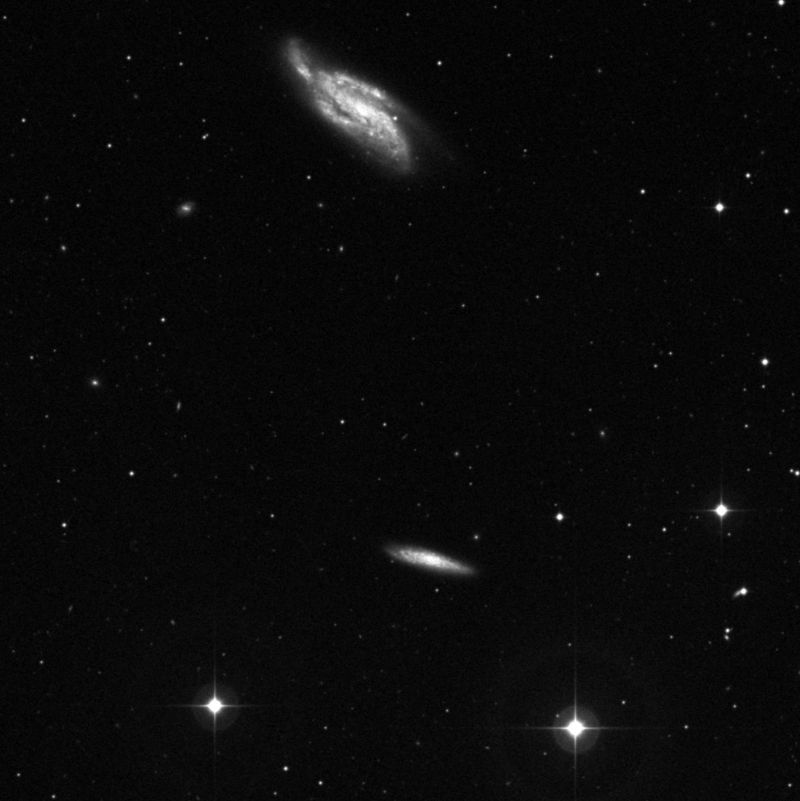
NGC4088 (the upper galaxy with 10th magnitude) and NGC4085 (12th
magnitude). The image is 20' wide.
The Digitized Sky Survey copyright © 1994
The fog cleared off at the beginning of the twilight, and I could spot
some 12th magnitude galaxies. Even so, transparency was not very good,
probably because there existed low density fog. Eyes of Night Owl Nebula
was clearly seen. M108 was about to disappear in the twilight.
We have fog many times at the observing site on the outer rim of the
crater, Volcano Aso, and I have ever experienced dew condensation with
windy condition a few times. Contrarily, no dew condensation occurred
under the windy weather in Niigata. Six months have passed since I began
to live in Kumamoto, but it takes some more time to get to know the lay of
the weather pattern here.
Sunday, September 23
It has been
nasty weather more than one month and I did not conduct a comet searching
session. There might be some days with clear sky, but on some days I could
not get out of my bed due to suffering from intense heat that resulted in
giving up observation. The other days I went to on a trip with lodging to
attend a scientific conference that made me impossible to observe. Anyway,
I must say it has been foul weather even if considering the
above-mentioned situation.
Last year
Stefan Kurti, a Slovak amateur astronomer, interviewed me and posted the
article on his web site. The article was published on an
August-September Issue of Slovak astronomical magazine, KOZMOS. In former
Czechoslovakia there were many famous comet hunters like Luboš Kohoutek,
Antonín Mrkos and Ľudmila Pajdušáková.

Covers of magazines. From left to right, gAmateur Astronomerh in China,
gAstronomyh in USA and gKOZMOSh in Slovakia.
Part of articles of
magazines. From left to right, gAmateur Astronomerh in China, gAstronomyh
in USA and gKOZMOSh in Slovakia.
Speaking of foreign astronomical magazine, articles on my comet hunting
activity were also published in gAmateur Astronomerh in China and
gAstronomyh in the USA.
I wonder how many astronomers are conducting comet hunting visually in the
world. I think the number falls off drastically, but last year I received
an email from a 20-year-old man from Ukraine. He said he wants to start
visual comet hunting and asked me some advice. There still is the young
man like him who pins his hope to visual searching.
In 2023 LSS
telescope that is larger in aperture, 8.4 m, than that of Subaru
Telescope, 8.2 m, will start its operation. LSS surveys the entire sky
only three nights. At present almost of all new comets are discovered by
Pan-STARRS telescopes, however, in five years the era when the telescope
with higher performance detects darker comets automatically. I believe it
is possible to discover a new comet visually before the operation. Maybe,
after that visual discovery is possible. I am happy if my article urges
visual comet hunters.
Wednesday, August 8 to Thursday, August 9
Wednesday
At the usual observing site there is light pollution in the east from Aso
city, and I decided to observe at another site. It was the
Zekkei Parking, Superb view Parking if I translate it with an
altitude of 920 m as shown No. 1 in the map. Aso city is located in the
southeasto of the parking that mitigates light pollution in the southeast
to the north.
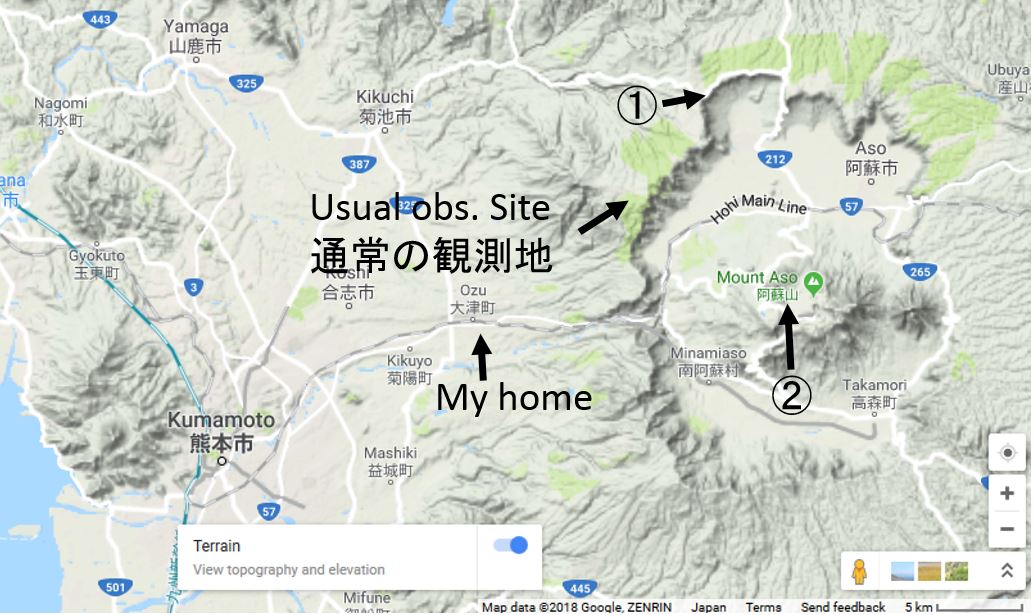
Usual observing site, Zekkei parking (No. 1) and Kusasenri-gahama parking
(No, 2).
The eastern sky was dark in spite of the moon phase of 26. I trained my
comet-seeker at 21P Giacobini-Zinner that was in the northern sky, and I
began to the session from the comet to avoid the moonlight. Though there
are many galaxies in the constellation of Camelopardalis and Ursa Major, I
could identified those of 10th magnitude or brighter: NGC2146, 2787, M81,
M82, NGC2985 and 2655.
Before 2a.m. local time to the daybreak, unexpectedly, many vehicles went
in and out of the parking that made me irritate. I probably do not visit
here in the future, but the season why many visit here was literally
superb view. When I completed the session and took down my comet-seeker, I
saw the image of dying Buddha above night view of Aso city that was being
covered with a fog. How solemn the scenery was!

The image of dying Buddha. The peaks of the mountain look like the image
of the Buddha entering nirvana. From left peak to the right his face,
breast and knees.
Thursday
I selected Kusasenri-gahama
(1138 m above sea level, shown in the map) with a 35 minute drive from
home as todayfs site. Contrary to the yesterdayfs site only two cars
passed the site. The eastern sky was rather dark even though there was
moon with phase 27. Incidentally, NGC1211 came into the FOV when I trained
my telescope at the southeast, and I started the hunting session from the
object. The deep sky objects that I came across were NGC1137, 1417, 1453,
1637, 1700, 1587-1589, 1788, 1999 and M42. I observed DSOs with the
magnitude of 12th or brighter that were darker than those of yesterday,
because the moon phase progressed.
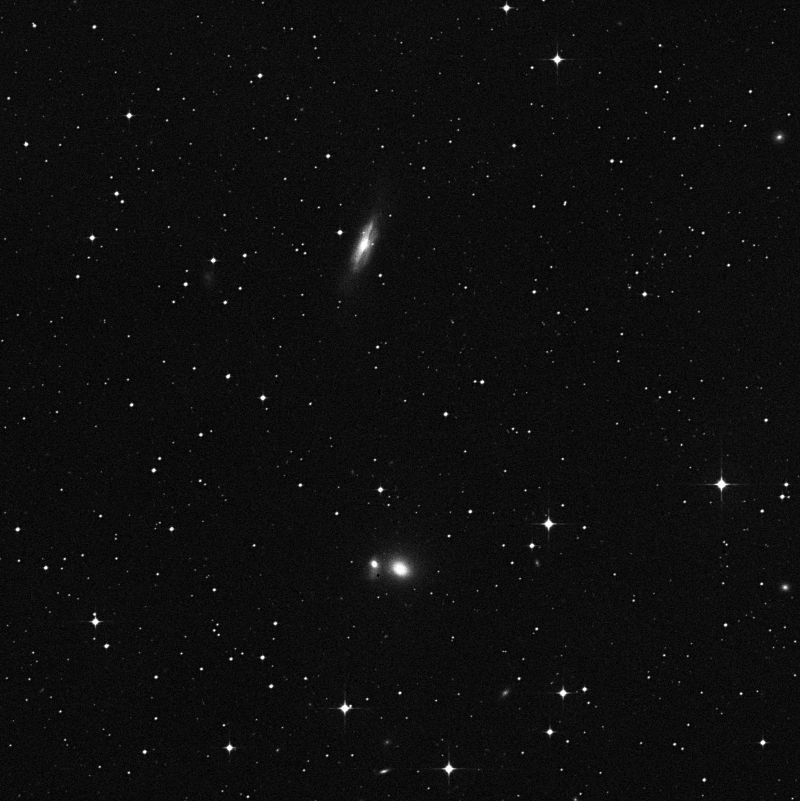
NGC1587 (lower center, brighter one), 1588 and 1589(upper
center). Image is 30f wide.
The Digitized Sky Survey copyright © 1994
The site is only 3
km away from the active crater at Aso
Nakadake. Upon finishing the session I noticed the smoke vomited
from the crater. If the volcano erupts the road to the site may be closed.
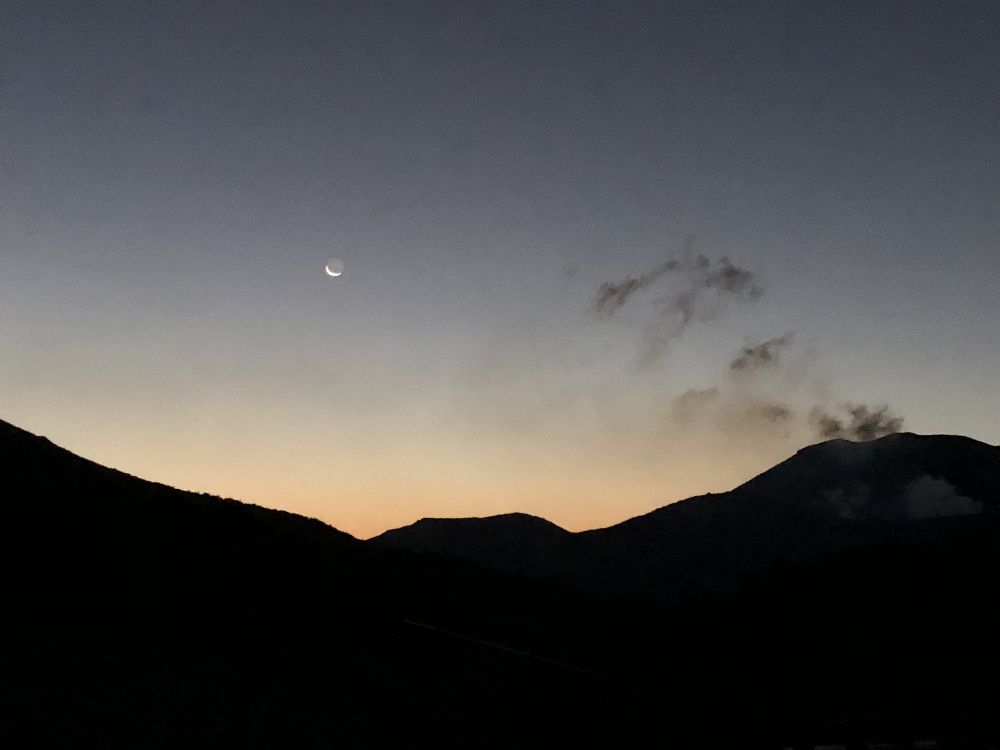
Active crater, Aso Nakadake, vomiting smoke.
Sunday, July 15 to Tuesday, 17 July
I conducted
comet hunting sessions for three consecutive predawn, though transparency
was not good due to high humidity on all days. On Monday, national
holiday, I went to a far site, Higotai Park, more than one hour by car.
The site is 970 m above sea level that is comparable the usual observing
site, i.e. the rim of the crater of Mt. Aso. However, Higotai Park is far
from major cities and one can observe fainter stars. I noticed the Milky
Way obviously looked wider than at usual site.
An acquaintance of mine abroad introduced me a handy site, light pollution
map.
https://www.lightpollutionmap.info/
According to Bortle Dark Sky Scale (https://www.handprint.com/ASTRO/bortle.html)
the darkness at the usual observing site is Class 4 (M33 is difficult with
averted vision), whereas at Higotai Park it is Class 3 (M33 is easy with
averted vision).
At predawn on Monday I identified 33 galaxies in the area around Pisces
and Cetus. The faintest one was UGC1062 with the magnitude of 14.3. I
often observed many galaxies in the same FOV. I think I have never
observed so many galaxies in the area during the searching session. The
next day, Tuesday, I swept the northeastern sky so that part of it
overlapped with that on Monday. Obviously, the number of galaxies I
identified was less in comparison with that on Monday.
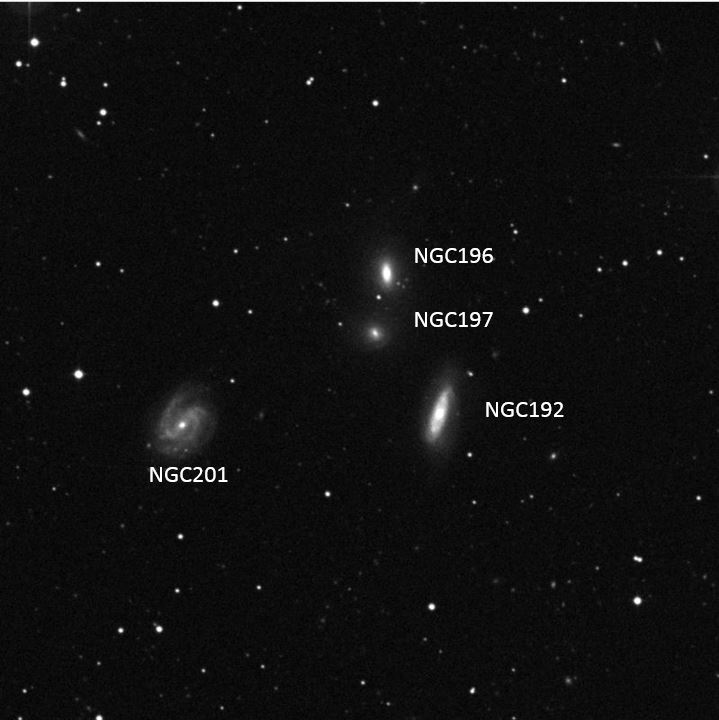
NGC192, 196, 197 and 201. Those galaxies were in the same FOV. The image
is 15f wide.
The Digitized Sky Survey copyright © 1994
In my college days at my parentsf house I could recognize M33 with direct
vision with ease that means Class 2 on Bortle Dark Sky Scale. At present
it falls down to Class 4. In Japan very limited places are evaluated as
the sky with Class 2. I estimate that it is possible to discover a comet
with the magnitude of 15 visually using my 46 cm comet-seeker. I have an
impression that it is not only robotic surveys but also light pollution
that threat visual discovery.
Monday, June 25
I was longing for clear sky during this rainy season and here it came. I
headed for the site expectantly. Nonetheless, fog appeared on the way and
the situation seemed to be the same as I approached the observing site.
Anyway, I had no choice. Upon arrival at the site the fog slightly cleared
off and I started setting up my comet seeker without hesitation.
Waxing moon was on the west that shed light on the ground around the site.
The moon set at 3:01a.m. local time, while the beginning of the twilight
was at 3:27a.m. The period of dark night was only 26 minutes. At 2:45a.m.
I trained my telescope at alpha Andromedae where I started the session.
The background in FOV was getting darker as the moon inclined toward the
west. A lower part of the sky was covered with fog, but the transparency
was good at higher altitude. Though I expected to identify some galaxies,
I could none of them even 15 minutes after of moonset.
At 3:27a.m. local time, i.e. the beginning of the twilight, suddenly, many
galaxies came into the FOV. I could identified five of them with ease:
NGC379, 380, 383, 385 and 403. Though it seemed that there existed more
galaxies in the FOV by refereeing to SkySafati 6 Pro, they were obviously
not comets and I continued the hunting session as I did not want to spend
time for confirmation.

A galaxy group of NGC383 (magnitude of 12.2) in the constellation of
Pisces. I identified the galaxies with NGC numbers on the image above,
though many others that looked like stars might be perceptible by my eye.
The faintest one was NGC385 with the magnitude 13.0. The image is 60f
wide.
The Digitized Sky Survey copyright © 1994
Four minutes after, M33 appeared at the center of the FOV with wonderful
spiral structure. After a few minutes I came across a pair of galaxies,
NGC499 and 507. The magnitude was 12.2 and 11.3, respectively. There are
some other brighter galaxies in the area, however, I could not observe
them. Probably, all galaxies except for M33 were ones that I observed for
the first time. It gave me a sense of satisfaction.
Sunday, June 24
I attended
the 48th Annual Comet Conference in Ishigaki Island, last weekend. The
conference dared to be held at the time of new moon. The local organizing
committee wanted to enjoy star gazing under the dark sky. I hesitated to
attend the conference at the time of new moon, but I did this time because
the value of clear sky has reduced after moving to Kumamoto as the chance
of fine days increased. Unfortunately, we could slightly see starry sky
due to approach of a typhoon.
My wife, her friend and I headed for Ishigakijima Astronomical Observatory
before the start of the conference. However, the observatory was closed. I
made a phone call and the answering machine said it was closed due to the
typhoon. The road to the observatory might be dangerous because of fallen
trees and landslide. We safely drove through the road but we were forced
to return.

Ishigakijima Astronomical Observatory
Today less comet hunters attend the conference in comparison with the
past. Even though Akihiko Tago, a discoverer of four new comet, took part
in the conference from Kobe. He had observed in Okayama Prefecture, but
moved to Kobe where his daughter lives due to aging. He said he stopped
observing because of old age.
Tago said he attended the Annual Comet Conference last in 1977 when I did
for the first time. I remember that many comet discoverers including Tago
and Minoru Honda took part in the conference at that time.
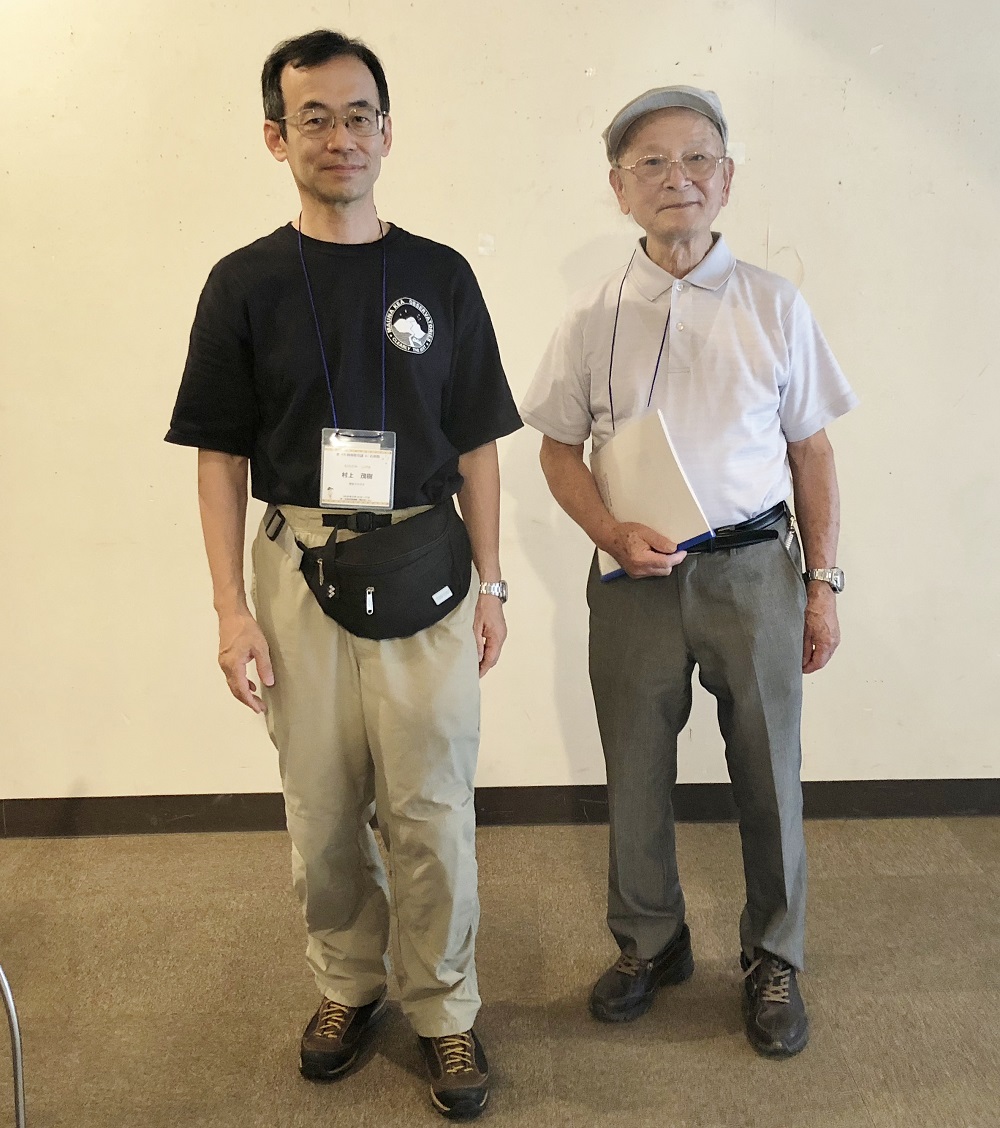
Akihiko Tago (right) and me.
I conducted a comet hunting session on Wednesday 13th June. We have few
clear sky now that it is rainy season, but the sky condition was the best
since I began to live in Kumamoto. C/2016 M1 PanSTARRS was 9th magnitude
with a tail. After observing the comet I began to search with theta
Pegasi, and identified nine galaxies including NGC7723 and 7600 with a
planetary nebula, NGC246. The condition was satisfactorily for this season
with good seeing for comet hunting, though there was cloud at an altitude
of 10 degrees and lower. The air temperature was10 degrees Celsius at the
site, contrarily, daily maximum was over 30 degrees near my workplace. The
site is in the inland with high altitude that causes large daily
temperature difference. One must be careful to keep in good
shape.
Thursday, May 24
This was the sixth comet
hunting session since having moved to Kumamoto. Ozu town where I live is
some 18 km away from the central part of Kumamoto City, i.e. my workplace.
The distance between my residence and the top of Mount Aso (1592 m) is
also about 18 km in a straight line. Considering the balance between work
and comet hunting Ozu is a very good town to live.
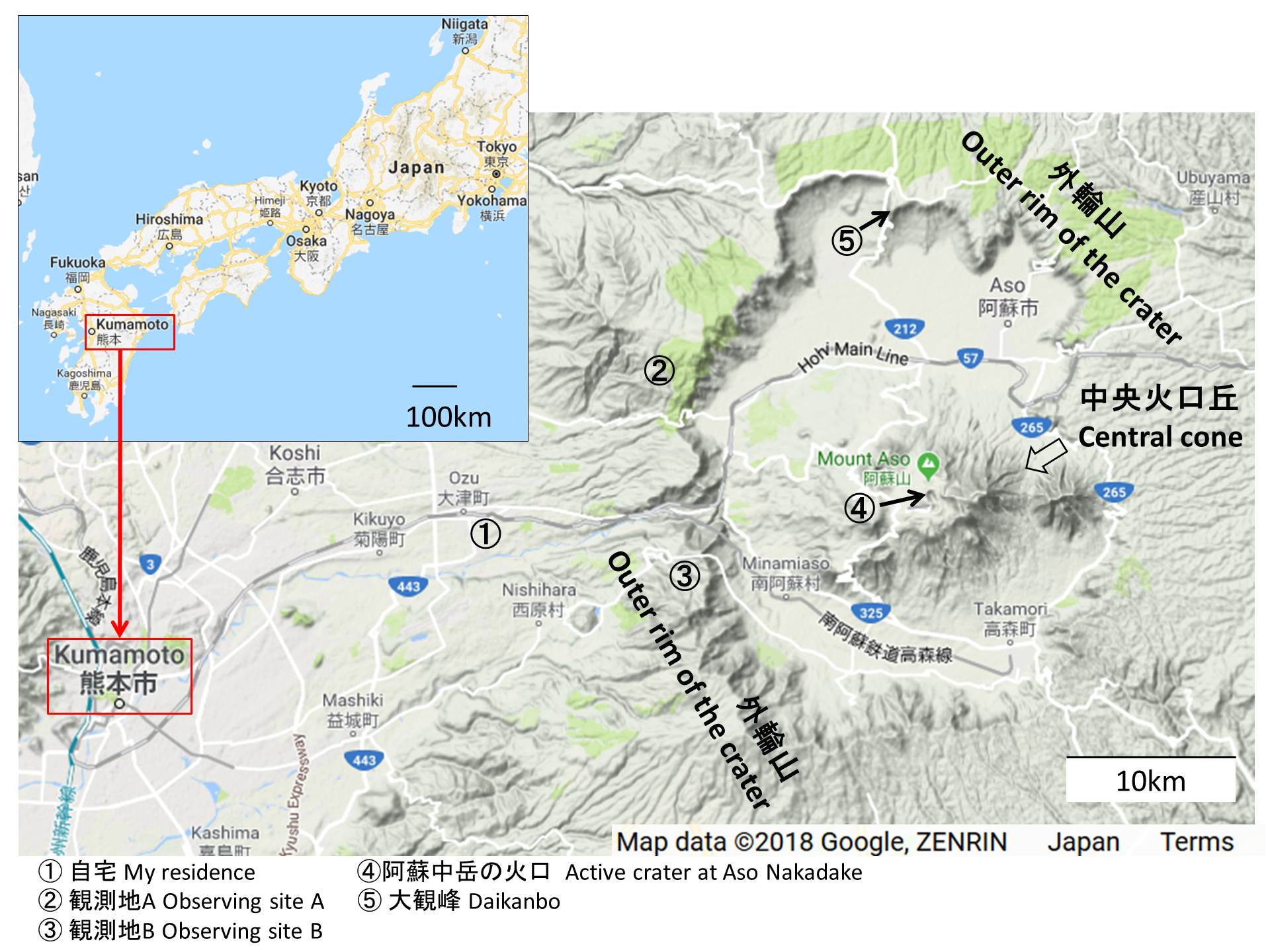
Locations of Kumamoto City, my residence, two observing sites. Active
crater at Aso Nakadake and Daikanbo Lookout are also indicated (refer to
photos below).

I visited active crater at Aso Nakadake that was vomiting smoke. The area
is kept out when the concentration of poison gas is getting high.
My observing sites are not near the top of the mountain, but at the outer
rim of the crater. There are two sites but I still do not know which one
is better. The siteA is at the altitude of 940 m, and the other is 730 m
and both of them are some 25-minute drive from my house. However, the
direction and a degree of the light pollution is different at each site.
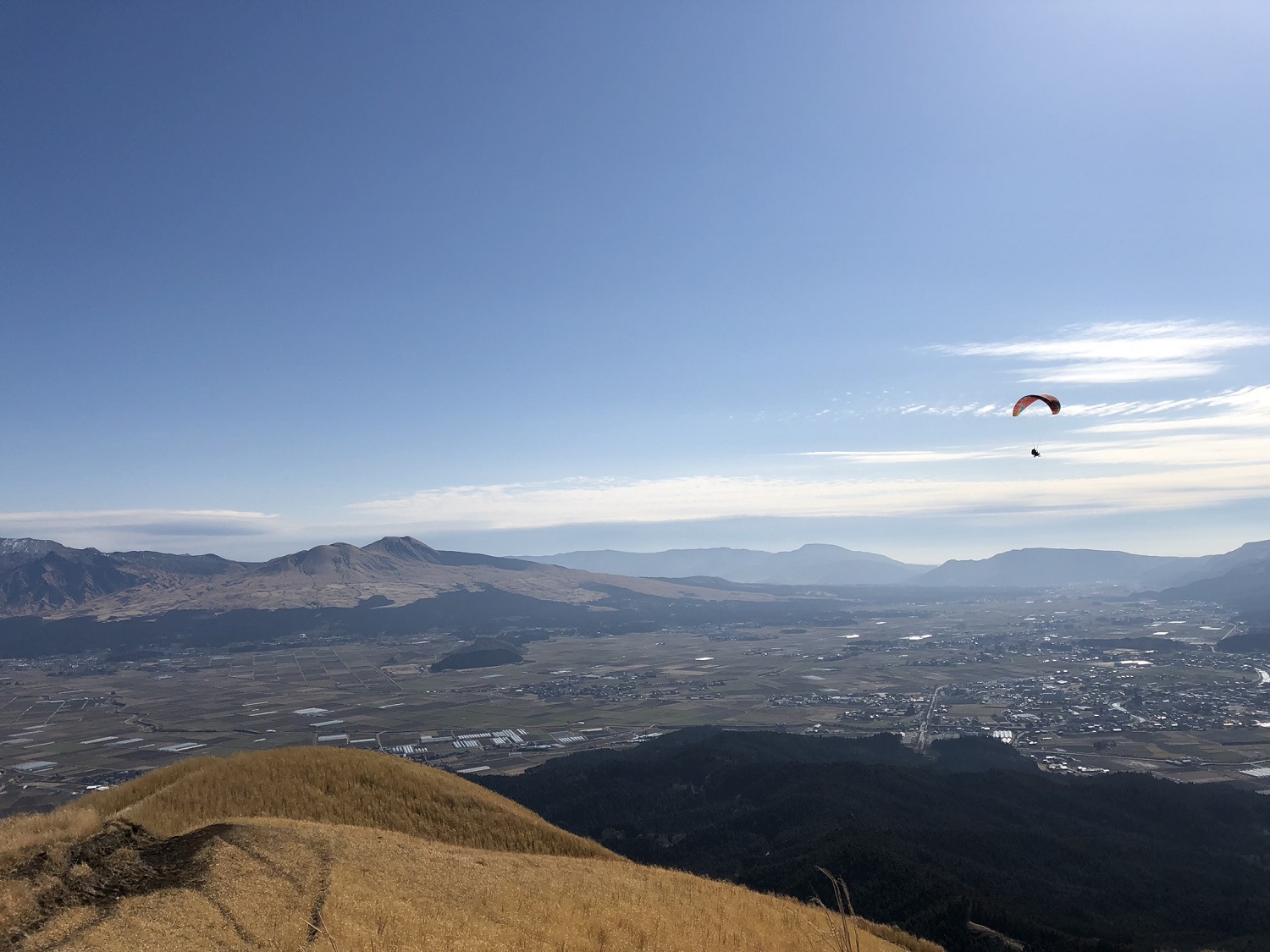
The central cone (from the center to the left) seen from Daikambo Lookout
(936 m) on the somma.
Today I started to search from Epsilon Pegasi, at 2:48am. The wind was
strong with poor seeing. I often reduce the magnification 97x to 78x,
because I cannot concentrate on the session under poor seeing, but today,
I used 97x throughout the session. At 3:30am wind got weak and suddenly,
seeing was improved. My level of concentration augmented, and as a result
I identified NGC7817, a galaxy with the magnitude of 11.8. There are many
galaxies as bright as NGC7817 in the Great Square of Pegasus, but today
NGC7817 was the only one I observed. I wondered if one of the causes for
poor seeing is that the morphology of the site in addition to strong wind.
During my course of the hunting session I observed C/2016 M1 PanSTARRS.
The comet was in the Milky Way with 10th magnitude, but I could not detect
the tail.
Though there were some 7 days with clear sky in May, I could conduct comet
hunting session only two days due to being busy with my work. It is sure
that the chance of clear sky is 2 to 3 times higher than that in Niigata
where I lived until March.
Sunday, April 15
Moving to Kumamoto
I have been transferred and moved to Kumamoto this month. I have been very
busy in March and after, and I scarcely conducted a comet hunting session.
There are three comet discoverers in Kumamoto: Nishikawa, Utsumomiya and
Kudo, with brisk activity on amateur astronomy.
It is easy to approach wonderful observing point, Aso, a volcano with high
elevation, from Ozu town where I live. The sky is much darker in
comparison with that in Tohkamachi, Niigata, where I lived and a chance of
clear sky is higher by far. It takes some time to get settled in but it is
sure that I will do fruitful comet hinting life than ever.
Friday, February 23
Though it has
been nasty weather of winter time, finally, I conducted a comet hunting
session for the first time this month. It took 45 minutes to start the
session after arriving at the observing site. The time needed for the
preparation is 25 to 30 minutes in summer, but it is time consuming to
wear clothes against cold protection in winter.
I aimed my comet-seeker at alpha Ophiuchi, Rasalhague, and began the
session at 3:48am local time. The sky suddenly got bright at around 4am
because ski resorts started field preparation for opening. The sky
condition is poor even if it is cloudless in winter due to the light
pollution from the ski fields. I my self is a skier, but I must say there
are too many ski resorts around my observing site. I can remember more
than a dozen of ski fields easily.
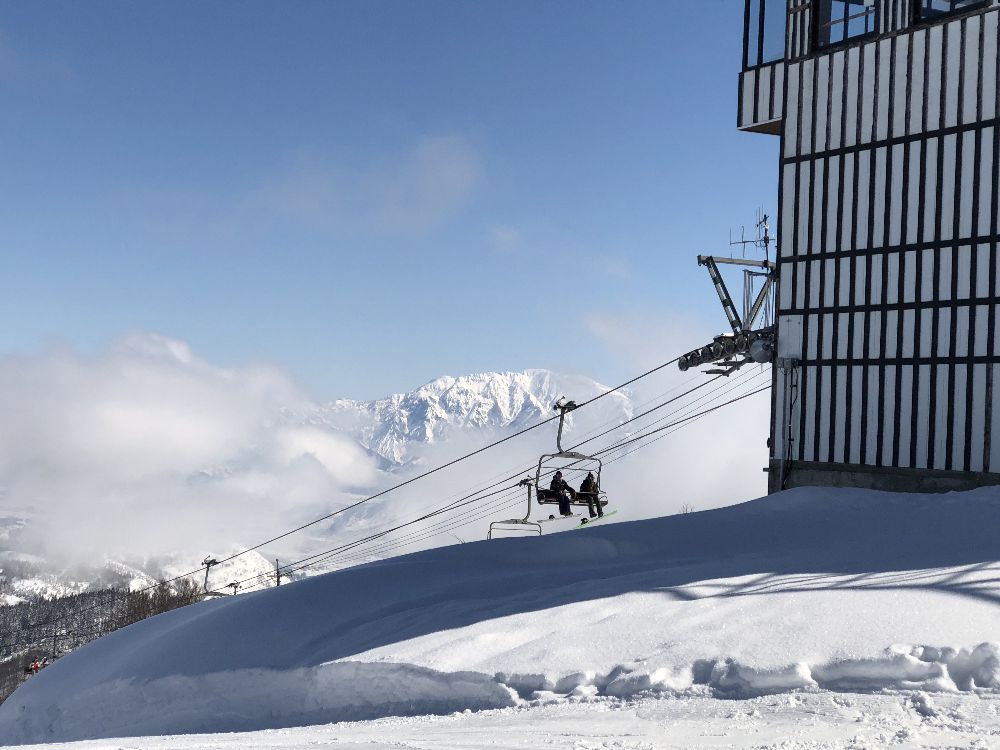
Jyoetsu Kokusai Ski Resort. The mountain in the background is Mt.
Hakkaisan.
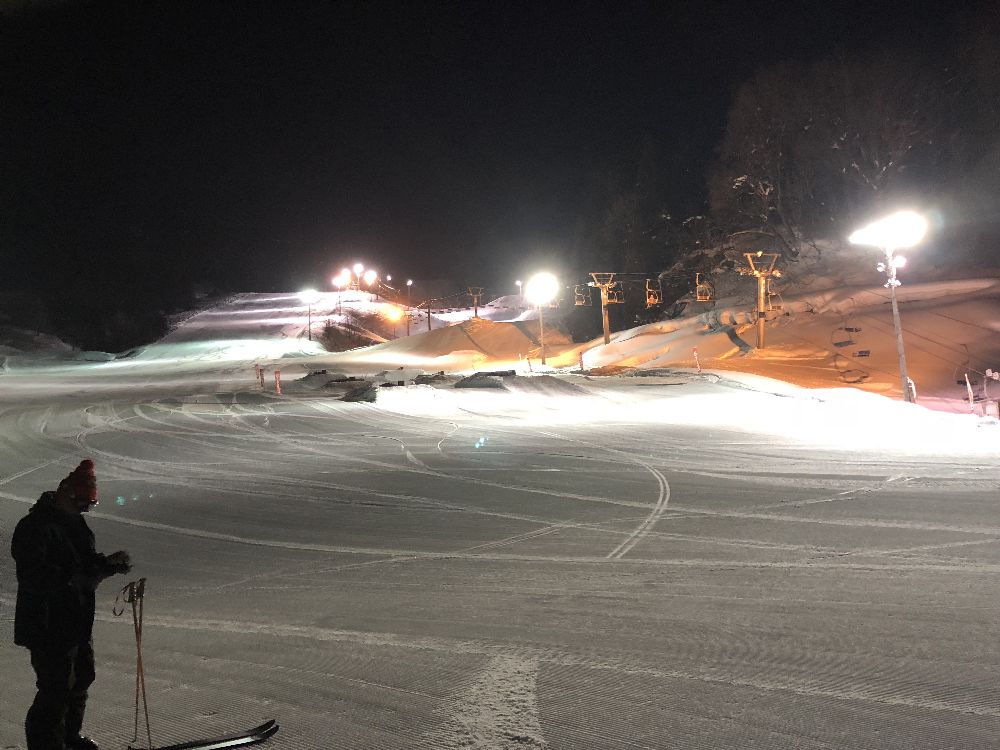
Matsudai Family ski field at night.
Returning to the comet hunting. The first deep sky object that came into
the FOV was NGC6633, a splendid open cluster. The next was NGC6760, a
ninth magnitude globular cluster. There was C/2016 M1 PanSTARRS 1.1
degrees north of the cluster, but I could not notice. NGC6760 looked an
11th magnitude globular cluster that I observe when the sky condition is
good. Then, I was relaxed to observe a wonderful double star, theta
Serpentis. The primary star looked yellowish and the companion light blue
that moved like a creature by scintillation. After identifying some open
clusters, I identified NGC6781, a planetary nebula in the constellation of
Aquila. I completed the todayfs session just after NGC9634, a globular
cluster in Delphinus, came into the FOV at 5:21am, 23 minutes after the
start of the twilight.
It was breezing with air temperature of -5 degree Celsius and I was a
little cold. I used a heater installed pants for the first time. It was an
excellent product like the heater installed vest (see Comet
hunting Wear).
Monday, January 28
I conducted
the first comet hunting session this year on Monday, January 1. Air
temperature was -10 degrees Celsius, the lowest record of all my hunting
session. I aimed at M12, a globular cluster in Ophiuchus, and identified
M10 and M14. No additional DSO was observed. Thin moon rose on the
southeast at the time when I completed the session.
After that we had some warm days, but it had been chilly and windy for
several days. I think there would be any clear sky this month from now on.
Ten years ago, the Italian binocular fan, Paolo Morini, asked me to write
a
report on my Russian Army Binocular 15x110. I wrote the original
article in English, and it was translated into Italian by Morini and into
Japanese by me, respectively.
The other day, he contacted me again and said he purchased the same
binocular, but there was a difference; mine was the type PNB-1 while his
was PNB-2.
http://rus.telescopes.ru/product.html?cat=3
He wanted to remodel his referring to mine, because the highest altitude
his binocular can be trained is 60 degrees. Actually, I modified my
binocular in 2016. I sent him the photos of my 15x110 binocular before and
after remodeling. The reason why I needed to modify was that the weight of
the main unit, i.e. the housing with the mount, was VERY heavy: 21 kg in
total. I was afraid to get strained back when I place it on the tripod at
the breast height.
 |
 |
Remodeled
15x110
binocular. The photo on
the right
Rigel Systems QuikFinder and the white dew cap (dangling) are atached.
Scales for an
azimuth and an altitude are installed that make it possible to identify a
deep sky object or a comet by combining with a digital map like SkySafari.
I bought the grip rod at a DIY shop that makes it easy to move the
binocular.
To solve the problem I remodeled the system so that the binocular housing
and the mount can be set up separately. The housing is attached to GIRO
ERCOLE Altazimuth Mount that is made in Germany via LBracket, and the
original tripod was replaced with GITZO GT5532LS. The mount is attached on
the tripod using the Losmandy Dovetail Plate. Using this system it is no
need to worry about having strained back.
GIRO ERCOLE
Altazimuth Mount
https://www.teleskop-express.de/shop/product_info.php/language/en/info/p4202_GIRO-ERCOLE
LBracket
https://www.teleskop-express.de/shop/product_info.php/language/en/info/p7917_TS-Optics-Optics-L-Bracket-for-binoculars-and-spotting-scopes.html
I will report on the detail of this binocular system at another time.
Top of this page
















